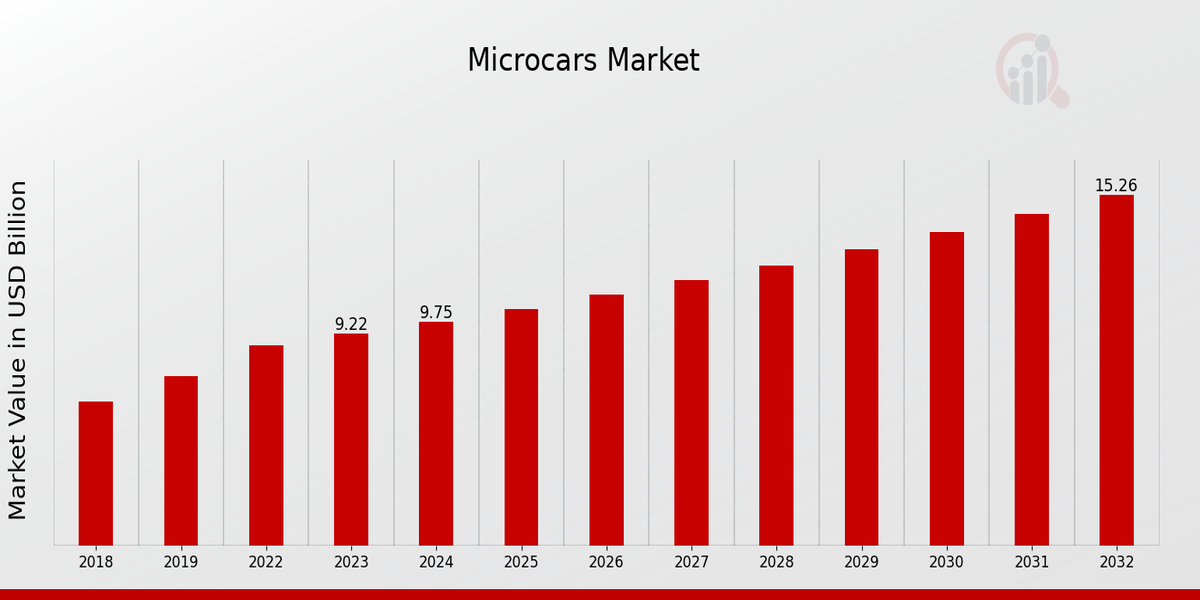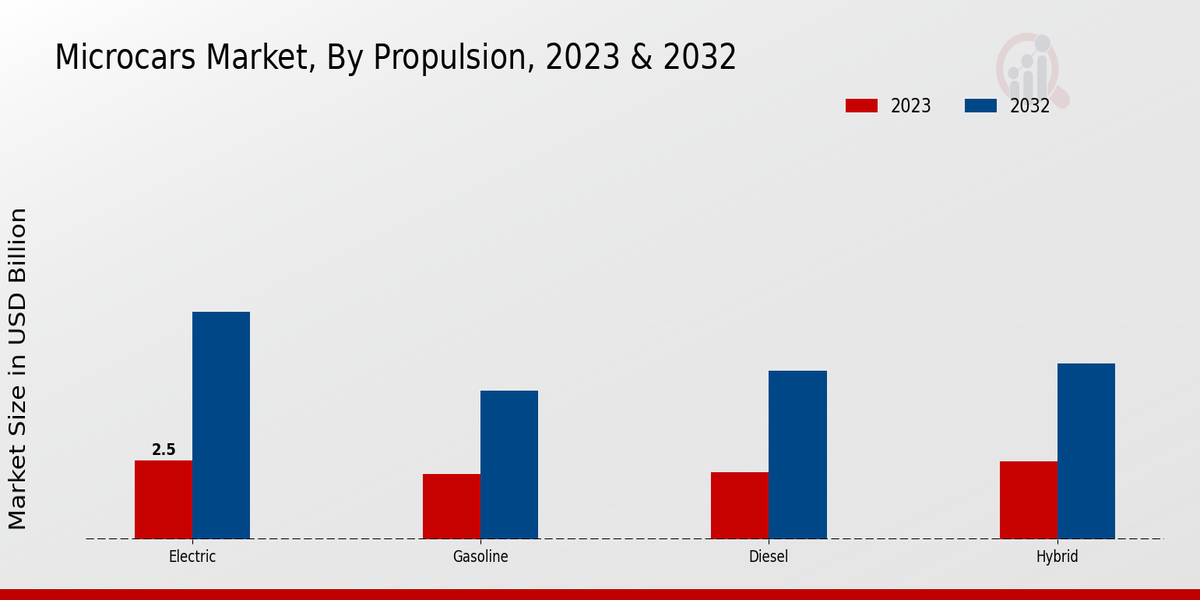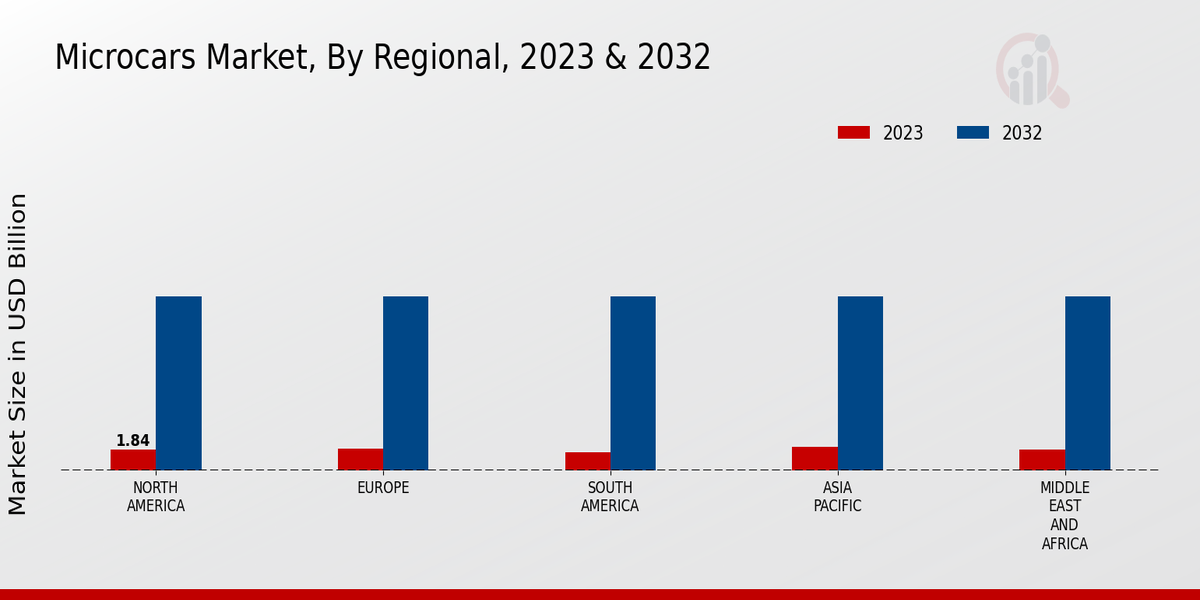Microcars Market Overview
As per MRFR analysis, the Microcars Market Size was estimated at 8.72 (USD Billion) in 2022. The Microcars Market Industry is expected to grow from 9.22 (USD Billion) in 2023 to 15.27 (USD Billion) by 2032. The Microcars Market CAGR (growth rate) is expected to be around 5.76% during the forecast period (2023 - 2032).
Key Microcars Market Trends Highlighted
Microcars, characterized by their compact size and fuel efficiency, are garnering increasing attention in the automotive market. Key market drivers include rising fuel prices, growing environmental concerns, and the need for affordable urban mobility solutions. Opportunities lie in expanding into emerging markets, developing innovative technologies for microcars, and catering to the growing demand for shared mobility services. Recent trends include the introduction of electric microcars, advancements in lightweight materials and construction techniques, and a focus on improving safety and performance. Automakers are also exploring subscription and rental models to tap into the growing demand for flexible mobility options. Overall, the microcars market exhibits strong growth potential and presents opportunities for innovation and expansion.

Source Primary Research, Secondary Research, MRFR Database and Analyst Review
Microcars Market Drivers
Rising Demand for Fuel-Efficient Vehicles
At present, due to the growing cost of fuel and the increasing environmental impact of transport vehicles, the demand for fuel-efficient cars is becoming more and more relevant. In this context, microcars, designed for a driver and, in some instances, one passenger, appear particularly advantageous, as they are smaller and lighter than conventional cars. As a result, their energy expenditure in terms of fuel efficiency is quite favorable. Another factor contributing to the increasing relevance of microcars is the widespread use of car-sharing and ride-sharing services as demands for cabs and private drivers escalate due to increasing urbanization and concentration of lifestyles, microcars seem even more suitable, as they are typically used on trifle passes, which are city-distorted in their most part.
Government Regulations and Incentives
With the proliferation of increasingly stringent carbon emission regulations worldwide by governments. Microcars have been seeing increasing support as authorities deemed them to be a low-emission mode of transport in comparison to traditional vehicles. Various countries offer lucrative financial incentives for microcar adoption, whether as tax exemptions or government-based subsidies. The lower market price of microcars benefits the consumers due to the reduced vehicle price.With majority of the governments’ support of microcars extending beyond financial incentives, investments are poured into infrastructure development including parking spaces and charging stations to facilitate microcar usage.
Technological Advancements
The development of electric and hybrid microcars is catalyzing the demand for advanced technological microcars. Hybrid microcars contain a gasoline engine and an electric motor that powers the vehicle effectively with fuel economic efficiency. They reduce individual gasoline usage and improve efficiency of the vehicles. Electric microcars offer zero emissions thus are much more environmentally friendly. Both are addressing the problem of vehicle ranges, since this is becoming quite high for electric microcars that are being designed.However, the cost of electric and hybrid microcars is exceptionally high, which may affect the demand to some extent. The attributes of better safety through advanced features and the advancements in connectivity have further improved the applicability of microcars for consumers.
Microcars Market Segment Insights
Microcars Market Propulsion Insights
The market of the Propulsion segment of the Microcars Market is expected to surge. It will be supported by increased environmental concerns and government regulations regarding green transportation. Electric vehicles are more likely to dominate the Propulsion segment market. It is expected to reach USD 6209.7 million in 2027. Electric vehicle popularity is explained by the fact that the domain does not have CO2 emissions and does not require large running costs. It also receives government support. Meanwhile, the gasoline-powered microcar market segment is expected to retain a considerable market share.Microcars, gasoline-powered vehicles, are more affordable. They are also more developed as there is a well-organized network of fuel stations. Nevertheless, the microcar market is expected to be harmed by the strict emission regulations.
To a certain degree, the market is invigorated by the rising cost of gasoline in the world. Diesel-powered microcars are not likely to have a prominent market share. They have significant CO2 emissions and are not as fuel efficient as EV or gasoline-powered microcars are. Moreover, a hybrid class of microcars, which combines an internal combustion engine with an electric motor, is expected to have a significant market share.The Revenue in the Propulsion segment of the Microcars Market will be equal to USD 15.27 billion in 2032. Such factors as the implementation of new products in the mass market, market players’ entry strategies, superiority of technologically advanced transmissions, and growing consumer awareness of green cars – eco vehicles will support the growth in this segment.

Source Primary Research, Secondary Research, MRFR Database and Analyst Review
Microcars Market Body Style Insights
The body style segment of the Microcars Market is quite diverse and comprehensive regardless of regional characteristics. Indeed, hatchback body styles in microcars are one of the leaders in the market, providing a high percentage in this segment. Such cars are one of the most versatile in terms of their configuration and, at the same time, their low cost and minimum dimensions. Sedans and saloons have a marginal percentage compared to hatchback body styles but represent a significant body style as relatively spacious microcars that are more comfortable for drivers.In turn, the percentage of SUVs is even lower than the indicators of sedans, but in previous years, it has become more popular with buyers from developing countries. The last position regarding the percentage of microcar body styles is held by convertibles as limited-use vehicles with a high purchase cost. Over the next years, the consumer market will contribute to a stable increase in market dynamics owing to an increase in people’s incomes and, as a result, the search for more premium and recreational transport.
Microcars Market Number of Seats Insights
The Microcars Market segmentation by Number of Seats offers insights into the different vehicle configurations available in the market. The '2' seat segment held the largest market share in 2023, accounting for approximately 55% of the Microcars Market revenue. This dominance is attributed to the high demand for compact and fuel-efficient vehicles in urban areas. The '4' seat segment is projected to witness significant growth during the forecast period, owing to the increasing popularity of family-oriented microcars. Moreover, the '6' seat segment is expected to gain traction, driven by the growing preference for spacious and versatile vehicles.The increasing demand for microcars with advanced features and enhanced safety is expected to drive the growth of the Microcars Market in the coming years.
Microcars Market Target Market Insights
The target market for microcars encompasses a diverse range of consumer groups, including urban commuters, budget-conscious consumers, and fleet operators. Urban commuters, who often face challenges with traffic congestion and parking availability, find microcars to be a convenient and fuel-efficient mode of transportation. Budget-conscious consumers are drawn to microcars due to their affordability and low operating costs. These vehicles cater to individuals and families seeking economical transportation solutions. Fleet operators, particularly those involved in rental and ride-sharing services, are increasingly adopting microcars to optimize their operations.The compact size and maneuverability of microcars make them well-suited for urban environments, contributing to the growth of the Microcars Market.
Microcars Market Regional Insights
The regional landscape of the Microcars Market showcases distinct market dynamics across various regions. North America, Europe, APAC, South America, and MEA represent key regional segments in the market. North America and Europe are expected to dominate the market throughout the forecast period, driven by factors such as stringent emission regulations, rising fuel costs, and increasing demand for compact and fuel-efficient vehicles.The APAC region is anticipated to witness significant growth, primarily attributed to the growing population, urbanization, and increasing disposable income in countries like China, India, and Southeast Asia. South America and MEA are expected to contribute a smaller share of the market, but they are expected to exhibit steady growth over the forecast period.

Source Primary Research, Secondary Research, MRFR Database and Analyst Review
Microcars Market Key Players And Competitive Insights
In an ever-changing market, several of the biggest players in the industry are focusing on expanding their product range to accommodate them. These businesses are already leaders in innovation and always strive to come up with new technologies to improve their cars’ performance and efficiency. Since the market for microcars is extremely vast, with many leading and new market competitors with market shares, the microcars market is considered highly competitive. Due to the nature of the business, competition is robust, and the fiercest competition contemplates the low prices of goods, their technological contribution as well as the product’s additional characteristics.
The key players operating in the industry are pursuing different strategies to keep up with the demand; the main strategies include investment in their research, turning ideas into reality, their cooperation to improve efficiency while maintaining their distribution network. Tata Motors, which is one the biggest players in the industry relative to the size of the microcars market n both the Indian territory and international sales, offers a wide variety of microcars. The company established the Tata Nano and the Tata Tiago as inexpensive and fuel-efficient microcars.
Tata Motors is a well-known brand whose strong proportionality in the microcars market can be attributed to its long history as the driving force of its car. The company’s product developments are in tandem with the latest trends in the car industry and the trend of producing electric microcars in particular. One of the biggest competitors in the industry is Bajaj Auto, a leading Indian firm. Bajaj Qute is a perfect quadricycle in urban and rural India, as evidenced by its market penetration. The company has therefore put an emphasis on the innovation and development of new technologies to boost its existing car line. The business has a long and compact distribution network and a solid presence in the big markets in which it operates. Captures significant market share, and profits have come through the purchase of inexpensive, unexpended, and fuel-efficient cars.
Key Companies in the Microcars Market Include
- Ford Motor Company
- Nissan Motor Company
- Maruti Suzuki
- Audi AG
- Toyota Motor Corporation
- Renault SA
- PSA Groupe (now Stellantis)
- Hyundai Motor Company
- General Motors Company
- Mahindra Mahindra
- Volkswagen AG
- Daimler AG (now MercedesBenz Group)
- BMW Group
- Bajaj Auto
- Tata Motors
Microcars Industry Developments
BMW Group
March 2025: BMW Group announced plans to expand its electric microcar lineup, introducing the BMW i1, a compact electric vehicle aimed at urban mobility.
Bajaj Auto
January 2025: Bajaj Auto launched the Bajaj Qute EV, an electric version of its popular quadricycle, targeting eco-conscious urban commuters.
February 2025: The company reported a 15% increase in sales of its microcars compared to the previous year, indicating strong market demand.
Tata Motors
February 2025: Tata Motors unveiled its latest microcar model, the Tata Nano EV, which features advanced battery technology and improved safety features.
March 2025: Tata Motors announced a partnership with local governments to promote electric microcars in urban areas, aiming to reduce congestion and emissions.
The microcars market is projected to grow from USD 9.22 billion in 2023 to USD 15.27 billion by 2032, exhibiting a CAGR of 5.76% during the forecast period (2023-2032). This growth can be attributed to factors such as rising urbanization, increasing disposable income, and growing environmental concerns among consumers. The market is witnessing the emergence of new players and technological advancements, driving innovation and competition within the industry.
Microcars Market Segmentation Insights
Microcars Market Propulsion Outlook
- Electric
- Gasoline
- Diesel
- Hybrid
Microcars Market Body Style Outlook
- Hatchback
- Sedan
- SUV
- Convertible
Microcars Market Number of Seats Outlook
Microcars Market Target Market Outlook
- Urban commuters
- Budget-conscious consumers
- Fleet operators
Microcars Market Regional Outlook
- North America
- Europe
- South America
- Asia Pacific
- Middle East and Africa
| Report Attribute/Metric |
Details |
| Market Size 2022 |
8.72(USD Billion) |
| Market Size 2023 |
9.22(USD Billion) |
| Market Size 2032 |
15.27(USD Billion) |
| Compound Annual Growth Rate (CAGR) |
5.76% (2024 - 2032) |
| Report Coverage |
Revenue Forecast, Competitive Landscape, Growth Factors, and Trends |
| Base Year |
2023 |
| Market Forecast Period |
2024 - 2032 |
| Historical Data |
2019 - 2023 |
| Market Forecast Units |
USD Billion |
| Key Companies Profiled |
Ford Motor Company, Nissan Motor Company, Maruti Suzuki, Audi AG, Toyota Motor Corporation, Renault SA, PSA Groupe (now Stellantis), Hyundai Motor Company, General Motors Company, Mahindra Mahindra, Volkswagen AG, Daimler AG (now Mercedes-Benz Group), BMW Group, Bajaj Auto, Tata Motors |
| Segments Covered |
Propulsion, Body Style, Number of Seats, Target Market, Regional |
| Key Market Opportunities |
Rising fuel costs Increasing urbanization Growing government support for electric vehicles Technological advancements Expanding market in developing countries |
| Key Market Dynamics |
Increasing fuel prices Growing urbanization Rising demand for low-emission vehicles Government incentives Technological advancements |
| Countries Covered |
North America, Europe, APAC, South America, MEA |
Frequently Asked Questions (FAQ) :
The Microcars market is expected to reach an overall valuation of 9.22 USD Billion in 2023.
The Microcars market is projected to reach an overall valuation of 15.27 USD Billion by 2032, exhibiting a CAGR of 5.76% from 2024 to 2032.
The Asia-Pacific region is anticipated to dominate the Microcars market, driven by increasing urbanization and growing demand for affordable and fuel-efficient vehicles in developing countries like India and China.
Microcars are primarily utilized for urban commuting, last-mile delivery, and car-sharing services due to their compact size, maneuverability, and low operating costs.

















